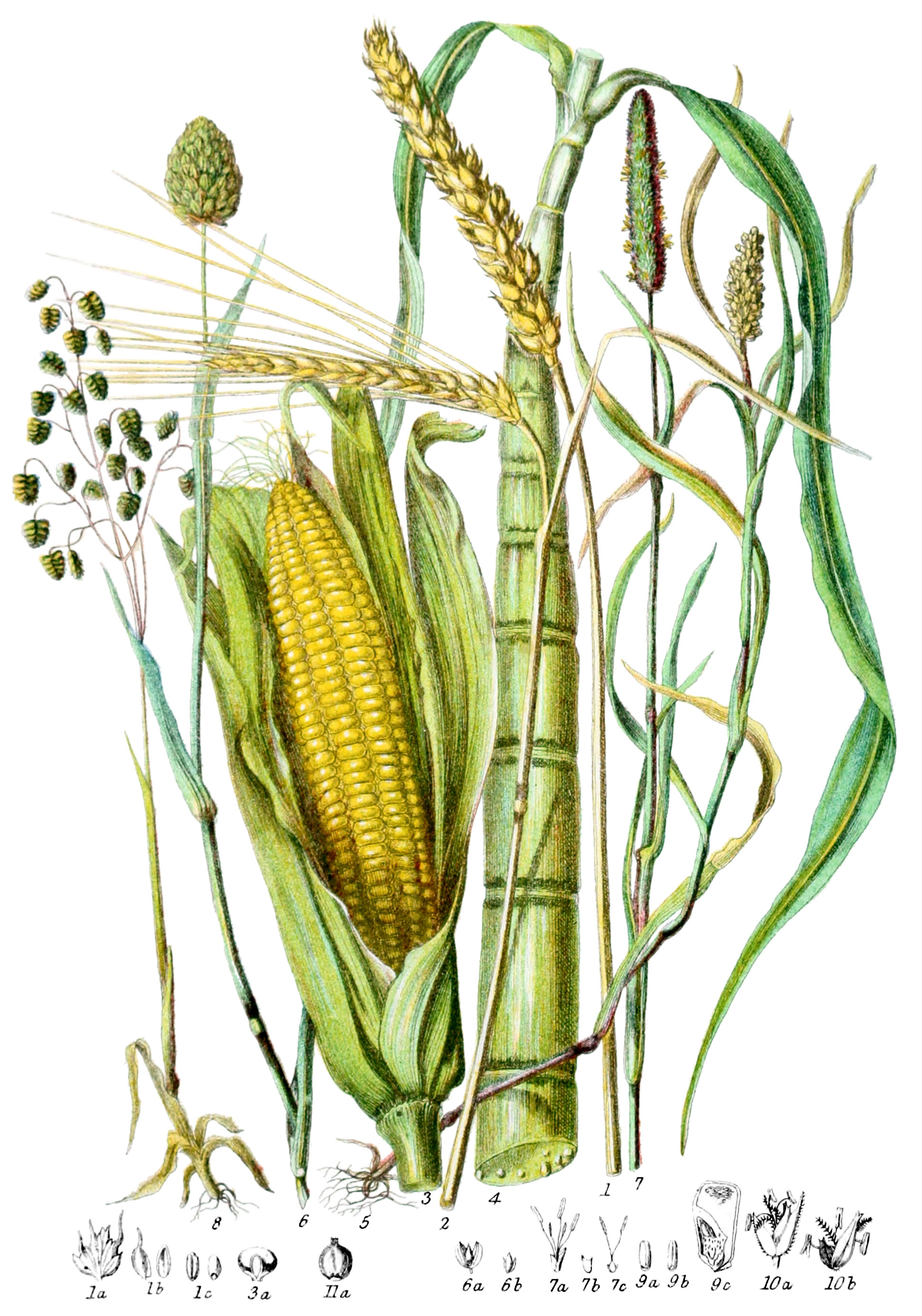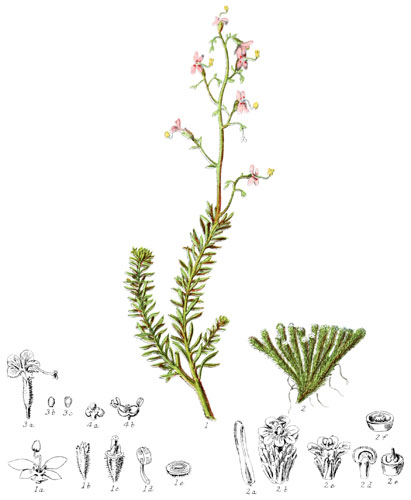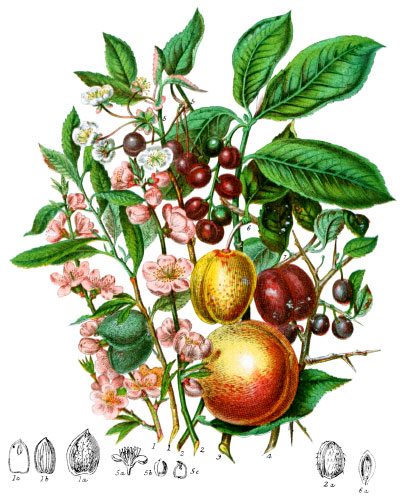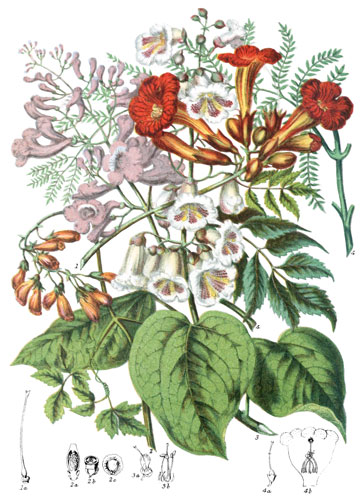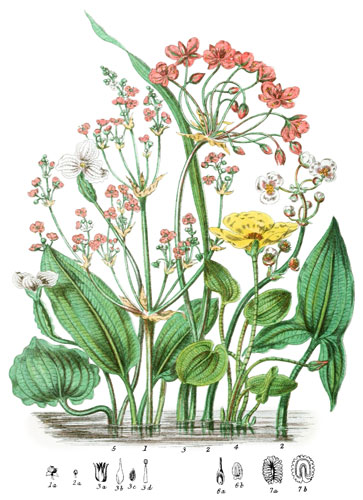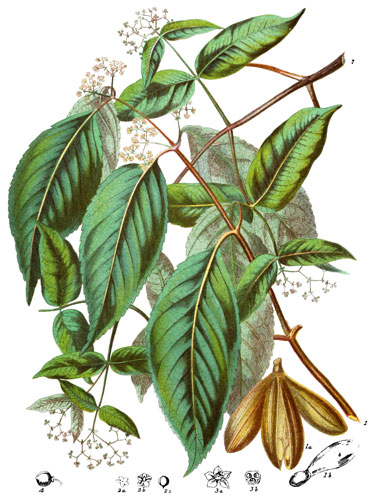Key characteristics
Herbaceous plants, the stems of which are sometimes large, and endure for many years. The root is a rhizome, either bulbous or fibrous. The stems are cylindrical, usually hollow, and closed at the joints, containing a considerable portion of silex, sometimes solid. The leaves are narrow, undivided, alternate, with a split sheath and membranous edge at the junction with the stem. The flowers are green, in small spikes, arranged on branching stalks, panicles, or spikes; the stamens and pistil are sometimes separate, the corolla is composed of imbricated bracts, the two outer glumes enclosing the inner glumes and the stamens; at the base of the ovary are two smaller scales. The stamens are generally three, occasionally six. The ovary is simple, with two or three styles, the stigmas feathery or hairy. The seed contains farinaceous albumen.
This Tribe has close affinity with Sedges, but is distinguished by the round and hollow stems, and the numerous bracts of the flower.
An abundant wholesome starch is contained in the seeds of many of these plants, an aromatic secretion exists in the leaves of others, and silex in the stems.
Since the Creating Word went forth, “Let the earth bring forth grass,” this tribe has been the most important throughout the whole range of vegetation. Nearly all the species are small in size, but having spreading roots extend over vast tracts of land in all temperate regions, affording large supplies of food to man and cattle. In the Tropics the species are of loftier growth, and for the most part stand singly.
Select plants in this order
Not all plants listed are illustrated and not all plants illustrated are listed.
- The tall, rapid growing Bamboo forms a kind of link with Calamus amongst Palms.
- Of all cultivated plants, corn ranks the highest, in the quality of the nutriment of its seeds, farinaceous matter and gluten being combined. It is not the most prolific, Wheat bearing generally 100-fold on one stalk; Rice 120-fold, and Maize as much as 800-fold in hot damp climates, though in the soil and temperature of California not more than 70-fold.
- The several species of Triticum (1) known as wheat, yield the best flour for bread, most esteemed in all ages, in all civilised countries.
- T. compositum is the ancient wheat of Egypt, and of excellent quality.
- The gluten is the chief ingredient causing the fermentation of bread, and has also the most nourishing property; this is more fully developed in the south of Europe than in the north, therefore the Macaroni and other preparations of wheat flour in Naples are superior to any manufactured in this country. Starch is obtained from wheat by steeping it in water and beating it in bags. The straw is of various uses; that grown on chalk soil is best for plaiting. The finest plait is made of straw pulled whilst green, and bleached during summer in the dry beds of rivers in Tuscany.
- Hordeum is a genus containing several species; H. pratense and H. murinum of Britain of no value as food; H. distichon (2) and others are the useful barley, a hardier plant than wheat, growing further north and ripening its grain under a less glowing sun.
- Avena, Oats, is hardy, and suited to a damp cold climate, it furnishes the oatmeal for the daily fare of all northern people, and the best food for horses.
- Secale, Rye, thrives further north than any other corn; in the north of Germany the black Rye-bread baked twenty-four hours is considered very nourishing; a coarser kind feeds horses.
- Zea (3) the abundant source of nutriment to the populous tribes of Indians both in North and South America, is the most luxuriant crop in appearanee; the wide leaves, the drooping panicle of stamen flowers on the summit of the stalk, the cluster of shining grain enveloped in the sheath below, render it an exceedingly beautiful plant. The general range of its culture is between 40° N. and S. on level plains, but on the elevated table-lands of Mexico it flourishes at 8680 feet, and on the Andes at 12,800 feet. It was introduced to the East Indies, China and Japan, but is not so general as rice. In N. America Indian corn is prepared in various ways for food.
- Z. curagua is the Valparaiso Cross-corn, the seed when roasted splitting into a cross.
- Saccharum (4), now the most essential luxury of man, one of the first objects of culture and commerce, was rare and only used medicinally in the time of Pliny. Growing wild in the East and West indies, China, Africa, S. America, and the Isles of the Pacific, it was first cultivated in the East; now sugar plantations exist in all favourable localities within a zone reaching to about 40° on either side of the Equator. It is remarkable that one of the greatest comforts of man should have been for two centuries the cause of the greatest misery; when it shall be cultivated only by free hands the enjoyment of it may be unalloyed. The jointed stem is as much as 12 feet high, yielding a plentiful supply of sweet juice when cut and crushed.
- An immense portion of food is afforded by Oryza, Rice; the chief requisite for its growth is irrigation, and that in a warm temperature; this can readily be found in most parts of India, the south of China, and Japan. The extensive rice-fields in Carolina sprung from a small quantity given by the Treasurer of the East India Company to a Carolina trader; transplantation had a good effect, and Carolina Rice is reputed to the best.
- Panicum italicum (5), a kind of millet, yields eatable seeds.
- The Indian Millet, Sorghum vulgare; in the West Indies it is the daily food of Negroes.
- Pharlaris (6) is cultivated in the Isle of Thanet, for singing-birds.
- Phleum (7) is one of the common grasses in pastures.
- Arundo, the largest British grass or reed, grows in deep ditches near the Thames.
- Many European grasses are found on lofty mountains in hot countries; Dactylis at 14,000 feet on the Andes, Poa and Festuca on the Himalaya.
- The most beautiful of all grasses are Gynerium argenteum and G. saccharoides, bearing silvery panicles above long leaves. The tall stems are used in St. Domingo and in Cumana, for arrows and other purposes.
- The glumes of Coix (11)* harden and enclose the seed, which hangs on slender stalks, and is called Job’s tear.
Locations
This tribe exists almost everywhere, from the Equator to Spitzbergen, and to Lord Auckland’s Isle. On mountains it ascends nearly to the limit of perpetual snow.
Legend
- Triticum æstivum, Wheat. The East.
- Cluster of Flowers.
- Glumes.
- Seed.
- Hordeum distichon, Barley. Tartary.
- Zea Mays, Maize, or Indian Corn. America.
- Seed.
- Saccharum officinarum, Sugar-cane. East Indies.
- Panicum italicum, Italian Millet. Italy.
- Phalaris canariensis.
- Seed with Glumes.
- Seed with Scales.
- Phleum pratense , Cat’s-tail Grass. England.
- Floret.
- Inner Glume.
- Ovary and Pistils.
- Briza media, Quaking Grass. South Europe.
-
- Seed of Rice.
- Inner Side.
- Section magnified.
-
- Flower of Agrostis alba.
- Flower without Glumes.
-
- Seed of Coix lacryma.
*11 was mentioned in the original description but only 11a was illustrated.
Explore more
Posters
Decorate your walls with colorful detailed posters based on Elizabeth Twining’s beautiful two-volume set from 1868.
Puzzles
Challenge yourself or someone else to assemble a puzzle of all 160 botanical illustrations.
